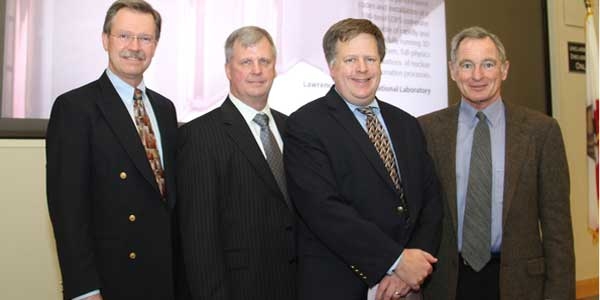Purple supercomputer fades to black
 (Download Image)
From left: Bruce Goodwin, Bob Meisner, Chris Maher and Michel McCoy in the Armadillo theater following the ASC Purple retirement ceremony Tuesday.
(Download Image)
From left: Bruce Goodwin, Bob Meisner, Chris Maher and Michel McCoy in the Armadillo theater following the ASC Purple retirement ceremony Tuesday.
ASC Purple, the first supercomputer capable of routinely producing the three-dimensional simulations of nuclear weapons performance that underpin stockpile stewardship, was retired in a Terascale Simulation Facility ceremony Tuesday morning.
Delivered in 2005, the IBM Purple machine represented the culmination of the Accelerated Strategic Computing Initiative's (ASCI) nearly 10-year quest to bring on line a machine capable of performing 100 teraFLOP/s (trillions of floating point operations per second), regarded by scientists and engineers as the minimum threshold for reliable 3D nuclear weapons performance simulations. The Stockpile Stewardship Program is tasked to ensure the safety and viability of the nation's aging nuclear deterrent without testing.
Bob Meisner, the National Nuclear Security Administration's (NNSA) Advanced Simulation and Computing program director, said that it was Purple that "took the 'i' out of ASCI" and transformed the ambitious initiative into the established Advanced Simulation and Computing program it is today. "Purple was the first machine that provided answers that we could believe in," Meisner said. "The machine proved that high-performance computing could be used as the third leg of science, along with theory and experiment. This was a huge accomplishment."
Bruce Goodwin, principal associate director for Weapons and Complex Integration, lauded the partnership with NNSA and IBM that made Purple possible, recalling that the contract that brought Purple and BlueGene/L to Livermore in 2005 came "on the heels of the Earth Simulator," the Japanese supercomputer ranked No. 1 on the Top500 list at the time.
In one of a number of firsts, Goodwin noted that the Purple system was the first national computational user facility available to scientists and engineers at the three nuclear weapons labs that make up ASC: Los Alamos, Sandia and Lawrence Livermore national labs.
"Purple was an iconic system. The goal of ASCI was to demonstrate an entry-level ability to run an integrated design calculation in 3D. This was achieved even as the machine was integrated," Goodwin said. "What is not as widely recognized is that this triumph was overshadowed by an even greater accomplishment: calculations that paved the way for the reorientation of the weapons program towards predictive simulation. Purple stood for both an end and a beginning and a computer can have no greater epitaph than this."
Purple was the last of a distinguished class of IBM supercomputers dedicated to the nuclear weapons program, a class that included ASCI Blue Pacific and White.
Goodwin said Purple's capabilities "have changed the world" in high-performance scientific computing and led to the discovery of new science and new physics. Phenomena revealed by Purple simulations made the "thermonuclear boost initiative possible."
A video featuring researchers' testimonials to the science Purple made possible was played during the ceremony.
Mike McCoy, head of LLNL's ASC program and master of ceremonies, paid tribute to the "extraordinary group of people" whose teamwork made Purple such a success; Livermore Computing, designers and code developers. Noting the sentimental attachment he and others developed to Purple, much like that for a beloved old car, McCoy quipped, "my garage isn't big enough to hold Purple."
Chris Maher, vice president for IBM's HPC Systems and Technology Group, said that while it was sad to be shutting down Purple "this opens up opportunities for the next machine, Sequoia, and the path to exascale. This is the kind of challenge we need."




